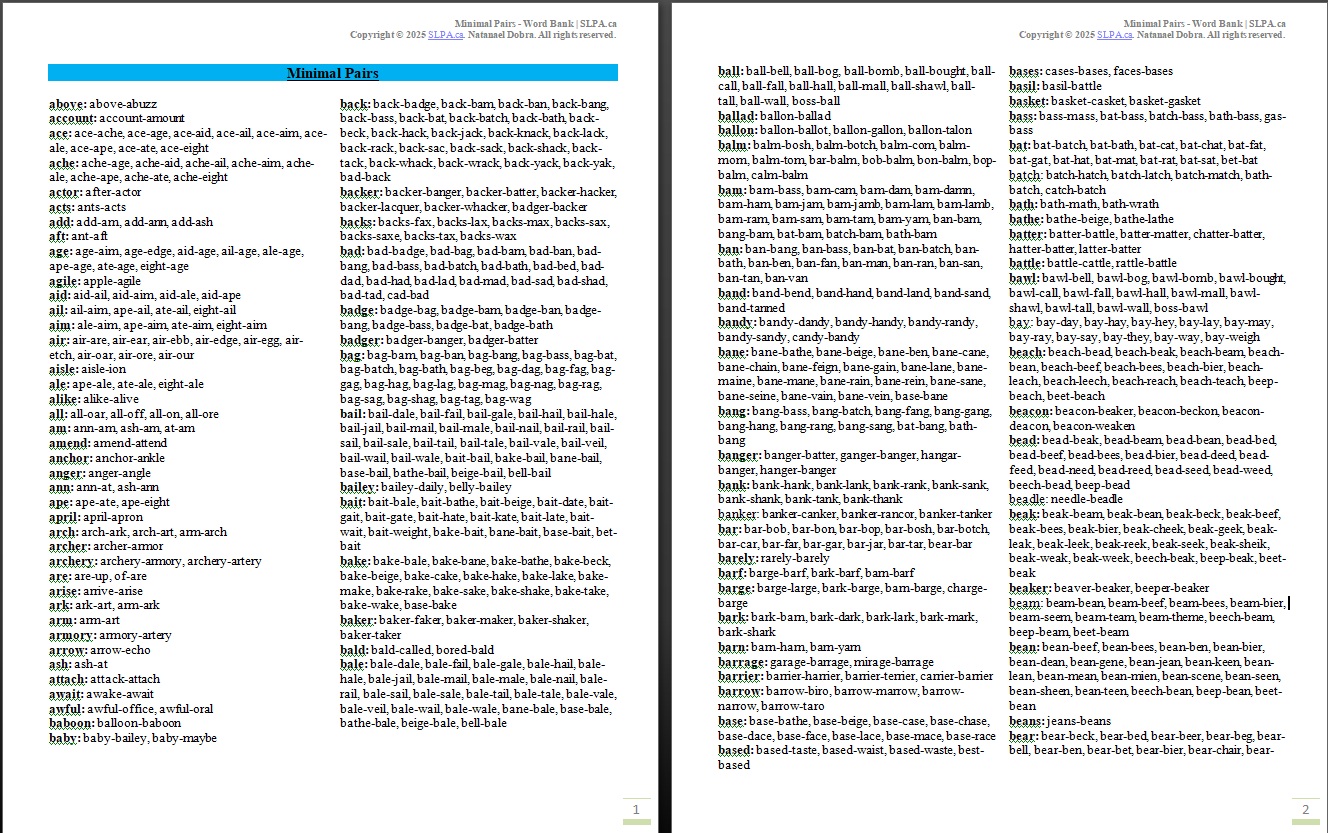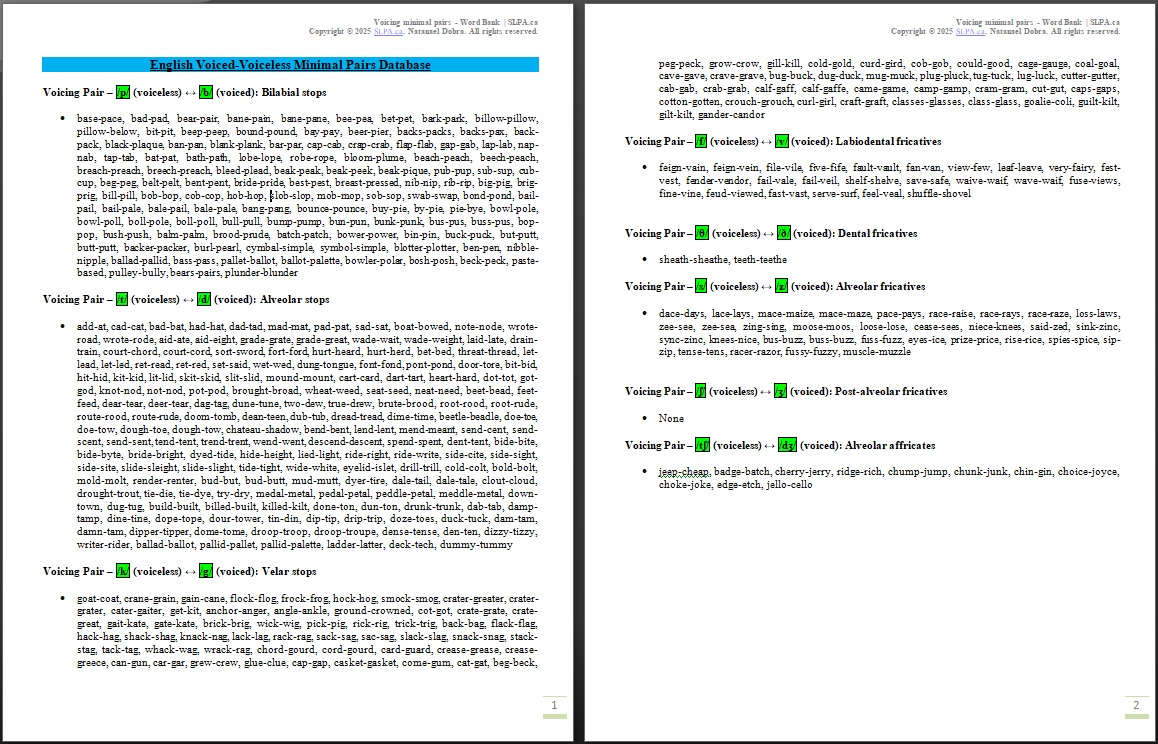English
- Details
- Written by: Natanael Dobra
- Category: English
- Hits: 113
Vowels and Diphthongs: Minimal Pairs - Word Bank
The list consists of minimal pairs, word pairs differing by one sound, focusing on vowels and diphthongs such as /aɪ/, /aʊ/, /eɪ/, /i/, and /oʊ/, like "file" /faɪl/ vs. "foul" /faʊl/, "ace" /eɪs/ vs. "ice" /aɪs/, and "boat" /boʊt/ vs. "bite" /baɪt/. In speech therapy, particularly for Childhood Apraxia of Speech (CAS), this list is crucial for helping children improve motor planning and phonological accuracy. Therapists use these pairs in repetitive, structured practice to target specific vowel or diphthong contrasts, aiding in clear articulation through auditory discrimination and production exercises. Beyond CAS therapy, the list is valuable in ESL classrooms for refining pronunciation and listening skills. It can also support literacy activities, such as spelling or phoneme identification tasks, and be incorporated into engaging games like minimal pair matching or bingo. Additionally, the list can be used in linguistic studies to investigate phonemic processing in various populations.

Vowels and Diphthongs: Minimal Pairs - Word Bank → Download Word Bank (PDF)
- Details
- Written by: Natanael Dobra
- Category: English
- Hits: 92
Minimal Pairs - Word Bank
The Minimal Pairs Word Bank is a comprehensive resource designed for speech-language pathologists, educators, parents, and researchers to support speech therapy for children with phonological disorders. It contains an extensive collection of English minimal pairs—words that differ by only one sound, such as "cat/hat" (/k/ vs. /h/) or "pen/pin" (/ɛ/ vs. /ɪ/)—targeting a wide range of speech sound contrasts, including consonants and vowels. Developed from a custom database of around 8,000 unique English words, meticulously curated over several years, this word bank enables children to practice distinguishing and producing sounds accurately through engaging activities like flashcards and games. By working with minimal pairs, children improve auditory discrimination, correct speech errors (e.g., saying "ship" for "sip"), and understand how sound changes impact meaning, leading to clearer communication. This versatile, user-friendly tool supports therapy, home practice, and English language instruction, promoting confident speech development.

Minimal Pairs - Word Bank → Download Word Bank (PDF)
- Details
- Written by: Natanael Dobra
- Category: English
- Hits: 98
Voicing Minimal Pairs - Word Bank
The Voicing Minimal Pairs - Word Bank is a specialized resource designed for speech-language pathologists, educators, and researchers to support speech and language therapy, particularly for addressing phonological disorders related to voicing contrasts. This database contains English minimal pairs—words differing by a single phoneme, such as base–pace (/b/ vs. /p/) or sheath–sheathe (/θ/ vs. /ð/)—where the differing phonemes are voiced versus voiceless counterparts (e.g., /p/ ↔ /b/, /t/ ↔ /d/, /s/ ↔ /z/). It is used in the conventional minimal pair approach to help individuals, especially children, distinguish and produce voicing contrasts through auditory discrimination and production practice, correcting errors like devoicing (e.g., saying pig for big). The word bank was created from a custom-built database of approximately 8,000 unique English words, thoughtfully curated over several years to ensure a robust and diverse set of pairs, supporting a wide range of speech and language therapy needs, from articulation practice to phonological research and English language instruction.

Voicing Minimal Pairs - Word Bank → Download Word Bank (PDF)
- Details
- Written by: Natanael Dobra
- Category: English
- Hits: 99
This section is your comprehensive hub for everything related to English approximant sounds—/l/, /r/, /w/, and /j/ (as in "yes")—within the context of articulatory speech therapy. You'll find in-depth resources on how each sound is developed and practiced, including tongue placement cues, visual aids, and therapy strategies tailored to common challenges. Explore interactive online tools, downloadable PDFs, printable worksheets, and word banks specifically designed for approximant sounds. Whether you're a speech-language pathologist, educator, or parent, this section offers everything needed to support clear, confident speech using these fluid, often tricky sounds.
Approximants are speech sounds made by bringing two speech organs close together, but not close enough to create turbulent airflow or friction. They are smoother and more vowel-like than other consonants. English approximants include /w/, /j/ (as in "yes"), /l/, and /ɹ/ (as in "red"). These sounds are all voiced and are often used in speech to create smooth transitions between other sounds.
- "L" /l/ – Voiced Alveolar Lateral Approximant - by syllable & position → Download /l/ Word List (PDF)
- "R" /ɹ/ – Voiced Post-Alveolar Approximant - by syllable & position → Download /ɹ/ Word List (PDF)
- "Y" /j/ – Voiced Palatal Approximant - by syllable & position → Download /j/ Word List (PDF)
- "W" /w/ – Voiced Labio-Velar Approximant - by syllable & position → Download /w/ Word List (PDF)





- Details
- Written by: Natanael Dobra
- Category: English
- Hits: 91
This section is your comprehensive hub for everything related to English nasal sounds—/m/, /n/, and /ŋ/ (as in "sing")—within the context of articulatory speech therapy. You'll find detailed instructions on how each nasal sound is taught, including airflow techniques, visual cues, and step-by-step therapy methods. Access interactive online tools, downloadable PDFs, printable worksheets, and curated word banks focused on nasals. Whether you're a speech-language pathologist, educator, or parent, this section provides all the essential resources to support precise nasal sound production and effective communication.
Nasals
Nasals are sounds produced by completely blocking airflow in the mouth while allowing air to pass through the nose. The soft palate (velum) lowers to open the nasal passage, giving these sounds their characteristic resonance. In English, the nasal sounds are /m/, /n/, and /ŋ/ (as in "sing"). All nasal sounds in English are voiced, meaning the vocal cords vibrate during production.
- "M" /m/ – Voiced Bilabial Nasal - by syllable & position → Download /m/ Word List (PDF)
- "N" /n/ – Voiced Alveolar Nasal - by syllable & position → Download /n/ Word List (PDF)
- "Ng" /ŋ/ – Voiced Velar Nasal - by syllable & position → Download /ŋ/ Word List (PDF)







